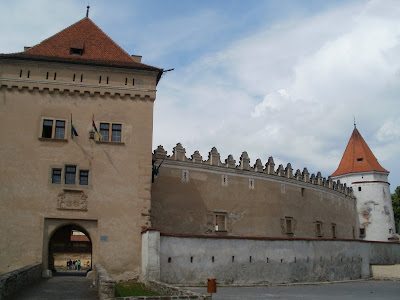2. There are some pretty good views of the Tatras there.

3. The town castle is at the end of the old square. It's got some exhibits in the different towers, like one about a doctor from the town who was the first in Slovakia to take x-rays, and of course arms and armor. At the end of the tour are some rooms with displays on life in the town in the 19th and 20th centuries, including census information that said that the highest number of Jews in the town, before the war, was over a thousand, but that in the 2001 census there was only one Jew. There was also an old wartime street sign for Ulica Adolfa Hitlera/Adolf Hitler Strasse. It was somewhat comforting that the sign had bullet holes in it.
 4. The castle's oldest tower has been significantly reconstructed and therefore has the safest stairs in all of Slovakia.
4. The castle's oldest tower has been significantly reconstructed and therefore has the safest stairs in all of Slovakia.5. The town's lyceum has a library that is supposed to be pretty impressive, but is closed on Saturdays.
6. Here is a tank called Jánošík, across the street from the back of the castle.

7. The Basilica of the Holy Cross, also reputed to be impressive inside, also seemed to be closed (maybe for a wedding).
8. I thought maybe visitors could go up in the Renaissance belltower next to the basilica, but it, too, was apparently closed. Or maybe I just wasn't looking in the right places to go in these sites.
9. I did peek inside the Greek Orthodox church, but it was modern and had no cool icons or anything.
10. The exterior of the New Evangelic Church is light red and green, for some reason. The inside is light, with a very high ceiling and a set of steps leading up to the altar. On the right hand side about halfway down the nave is the mausoleum of Imre Thököly, a Hungarian nobleman who was a native of the town and supported Protestantism.

11. The best reason to go to Kežmarok is to see the UNESCO-listed articulated wooden church. It's right next to the new Lutheran church, and despite the name, the outer walls are plastered, so I wandered most of the way around it going, "What is this strange building?" before seeing the sign that said it was in fact the wooden church.
During the 17th and 18th century Slovakia (among other parts of Europe) had some of those laws that said that Protestants could build churches as long as they didn't use any nails. They also had to build on specific sites outside towns, they couldn't have towers or bells, and parishes had to pay for construction themselves. In the case of this particular church, there are two small stone rooms at the back (actually to the right of the altar, but on the side opposite the entrance) that were given to the church by the town.
The church was built in 1717 on a Greek cross plan. It measures 35 meters long, 31 meters wide, and 20 meters high (115'x102'x66'). The walls are made of red fir, the supporting columns of yew, the hardest wood found in Slovakia, and the altar and pulpit of lime. With the ground floor and six balconies, there is room for 1500 people.
 In this picture, taken stealthily from behind the pulpit, you can see that the church looks like the prettiest barn you've ever been in. The ceiling is painted like a partly cloudy blue sky, with saints around the edges. The altar looks like it's marble because it's painted so nicely. Everything is beautifully carved and painted, and most of the writing, like the saints' names and inscriptions near the altar, is in German. There aren't that many pictures of the interior online, which is disappointing, because it is very nice; but on the other hand, pictures aren't as cool as actually walking in and seeing it yourself.
In this picture, taken stealthily from behind the pulpit, you can see that the church looks like the prettiest barn you've ever been in. The ceiling is painted like a partly cloudy blue sky, with saints around the edges. The altar looks like it's marble because it's painted so nicely. Everything is beautifully carved and painted, and most of the writing, like the saints' names and inscriptions near the altar, is in German. There aren't that many pictures of the interior online, which is disappointing, because it is very nice; but on the other hand, pictures aren't as cool as actually walking in and seeing it yourself.
No comments:
Post a Comment